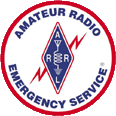|
| About Us |
| What's New |
| Preparedness |
| Drills/Exercises |
| Training |
| Operations (SOP) |
| Frequencies |
| Links |
| Site Index |
| Membership |
| Projects |
| Home |
| City of Cupertino |
| Contact Us |

Field Responder Certification
A CARES member with a Field Responder Certification is deemed to be qualified to assume the position of the lead CARES responder at an emergency field site. These individuals would work directly with the field site manager.
Before beginning this certification program, download and read Sections 3 and 7 of the CARES Training and Certification Plan for detailed information and training forms.
A Field Responder Certification will be granted to any individual who satisfies the following:
- Completes the Field Responder Certification Training (see Section 7, Table 2: Field Responder Qualification Training Plan)
- Successfully demonstrates the skills required for the position (see Section 7, Table 6: Field Responder Certification Evaluation Checklist)
- Receives a recommendation for certification from the candidate’s Training Mentor.
The following describes the steps needed to be granted a Field Responder Certification.
Step 1. Before Beginning
All CARES members interested in pursuing a certification should inform the EC or Training Coordinator of their intent to pursue the certification.
Step 2. Perform the Training Activities
There are 14 study/activity areas that must be completed for a member to be granted this certification.
- Overview of Operations. On completion of this activity, you will understand the 5 operational phases that CARES members will encounter and the objectives of each phase. This requirement can be satisfied by either attending a CARES-sponsored Field Responder Prep session or self-study of the appropriate sections in the CARES SOP Part 2, Section 5.
- Roles and Responsibilities. On completion of this activity, you will be able to describe the key roles and positions required to be staffed during an emergency response. This requirement can be satisfied by either attending a CARES-sponsored Field Responder Prep session or self-study of the appropriate sections in the CARES SOP Part 2, Section 6.
- Operating Procedures. On completion of this activity, you will understand the key operating procedures that you will encounter during an activation. This requirement can be satisfied by either attending a CARES-sponsored Field Responder Prep session or by self-study of the appropriate sections in the CARES SOP Part 2, Section 7.2, 7.3, 7.4.
- Emergency Net Logistics. On completion of this activity, you will be able to describe the different emergency net operating environments and how to operate within each type. This requirement can be satisfied by either attending a CARES-sponsored Field Responder Prep session or self-study of the appropriate sections in the CARES SOP Part 2, Section 8.
- Equipment Preparedness. On completion of this activity, you will be able to describe the kinds of material we must have for a successful deployment. This requirement can be satisfied by either attending a CARES-sponsored Field Responder Prep session or self-study of the appropriate sections in the CARES SOP Part 3, Section 11.
- Fire Department Checklists. On completion of this activity, you will be able to locate the 3 Cupertino Fire Stations and their associated Antenna drops. This requirement can be satisfied by either attending a CARES-sponsored Field Responder Prep session or self-study of the appropriate sections in the CARES SOP Part 5.
- Personal Safety Reading. Above all, each member must maintain their personal safety as their NUMBER ONE priority. On completion of this activity, you will understand what you must do to remain safe regardless of the situation you may encounter. This requirement can be satisfied by self-study of the appropriate risk sections as presented by the Red Cross on Personal Safety. CARES members should focus their study effort on risks that exist in Cupertino (Earthquake, Fire, Flood, Terrorism).
- SEMS, or Standardized Emergency Management System, is the emergency management structure used in California. On completion of this activity, you will be able to describe SEMS and how it relates to message routing. This requirement can be satisfied by either attending a CARES-sponsored SEMS Orientation Training session or taking and completing the SVECS SEMS Self-Study course.
- ICS 214 Log. On completion of this activity, you will understand how to use the ICS 214 form to keep sufficient records at your field location. This requirement can be satisfied by either attending a CARES-sponsored Field Responder Prep session or self-study of the appropriate section in the CARES SOP Part 6.
- Message Handling Orientation. Message handling is the foundation of what we do as part of a field responder. On completion of this activity, you will be able to describe how to create, pass, and receive a 3rd party and self-originated messages. This requirement can be satisfied by either attending a CARES-sponsored Message Handling Orientation Training session or self-study of the Message Handling and Open Nets training session material.
- Message Handling Drill #1. This requirement only can be satisfied by participating in a CARES field communications drill. Contact the EC for information on the number of drills you have and the number you need to satisfy this requirement.
- Message Handling Drill #2. Same as above.
- Message Handling Drill #3. Same as above.
- GoKit. On completion of this activity, you will have assembled a minimum configuration GoKit that can support a 12 hour deployment. This requirement can be satisfied by assembling a kit and demonstrating your ability to maintain communications continuity in the field independent of commercial power. Refer to the CARES SOP Part 3, Section 11 for equipment recommendations.
Step 3. Schedule a Certification Review
On completing all the Training Activities, inform the EC or Training Coordinator that you are ready for a certification review. This will be scheduled for you.
updated: February 17, 2007
